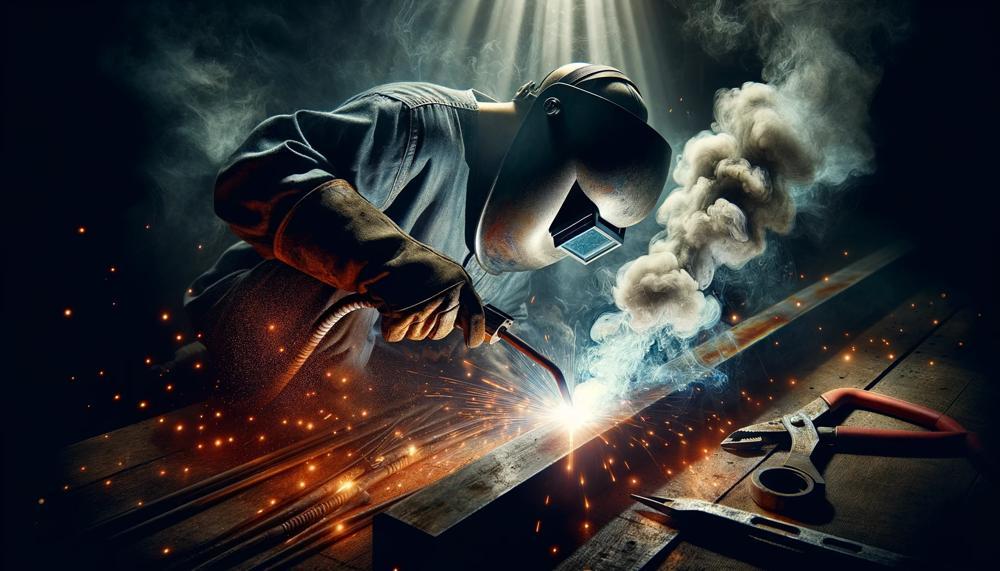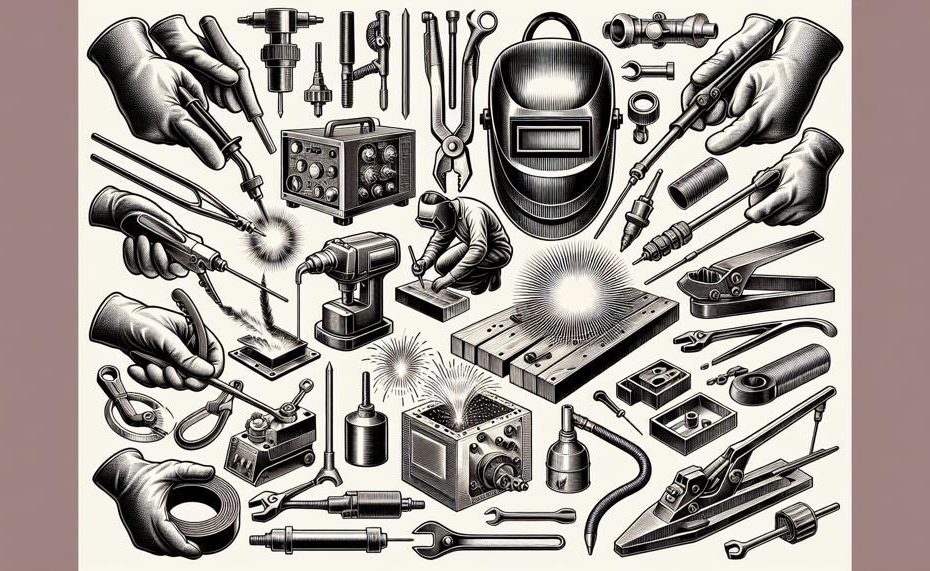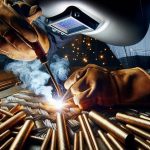Are you ready to spark your curiosity and ignite your welding skills? Look no further, as we delve into the age-old question: is MIG welding easier than stick welding? Both methods have their own unique strengths and weaknesses, making it crucial to understand the differences before embarking on a project.
So, Is MIG Welding Easier Than Stick Welding?
MIG welding is generally easier for beginners to learn than stick welding. However, setting up MIG welding equipment can be complex.
MIG welding uses a feed wire that runs through the machine at a preselected speed. This makes the process relatively fast and produces consistent welds. Some say MIG welding is fairly easy to pick up but a bit hard to master.
Stick welding uses a charged metal stick to provide an arc at a high temperature. The arc transmits an electric current from the welding stick to the metal to form joints in the material. Some say stick welding is more difficult to master than MIG welding.
Let’s get started.
Contents
Benefits Of MIG Welding
MIG welding is a popular choice among welders for its various advantages over stick welding. These include faster welding speed, less slag production, wider range of bead styles and patterns, and a wider range of settings and wire types available. Compared to stick welding, MIG welding is also more beginner-friendly, requiring less skill to produce quality welds.
One of the main benefits of MIG welding is its faster welding speed. This is due to its continuous wire feed system, allowing for a more efficient and consistent flow of filler metal. In contrast, stick welding involves starting and stopping frequently to replace burned electrodes, resulting in slower progress.
Apart from its faster speed, MIG welding also produces less slag than stick welding. Slag is the byproduct that forms on top of the weld and needs to be chipped off after cooling. With MIG welding, there is very little slag to remove, saving time and effort in the clean-up process.
Additionally, MIG welding offers a wider range of bead styles and patterns compared to stick welding. This allows for more creativity and versatility in various welding projects. The process also has a wider range of settings and wire types available, making it suitable for a wide range of materials and applications.
In terms of skill level, MIG welding requires less expertise to produce quality welds compared to stick welding. This makes it a more beginner-friendly process, making it easier for new welders to learn and master. It also makes it a more efficient option for experienced welders when working on larger or more complex projects.
Overall, MIG welding is known for its speed, cleanliness, versatility, and beginner-friendliness. However, it’s important to note that both processes have their own strengths and can be used interchangeably depending on the project at hand.
Benefits Of Stick Welding
Shielded metal arc welding (SMAW), also known as arc welding or stick welding, has gained popularity due to its numerous benefits over MIG welding. These include:
- Versatility: Stick welding can be used for all types of joints and metals, including rusted and damaged base metals. It also offers more freedom with bead styles and patterns compared to MIG welding.
- Portability: With less equipment needed and easier transportation, stick welding is a popular choice for outdoor or mobile welding jobs.
- Variety of electrode options: Stick electrodes come in various types, allowing for more specialized use based on the project’s needs.
- Cost-effective: Generally less expensive than MIG welding, stick welding is a great option for those on a tight budget.
- Adaptable to adverse weather conditions: Unlike MIG welding, which can be affected by wind and rain, stick welding works well in outdoor environments and can withstand adverse weather conditions.
- Beginner-friendly: While all welding techniques require practice and skill, stick welding is often considered easier to learn compared to MIG welding.
- Suitable for thicker materials: Stick welding can handle thicker materials better than MIG welding, making it a preferred method for heavy-duty projects.
| Benefits of Stick Welding | Potential Drawbacks of Stick Welding |
| – Versatility | – Messier process compared to MIG |
| – Portability | – Not suitable for thinner materials or high-end interior work |
| – Variety of electrode options | |
| – Cost-effectiveness | |
| – Adaptable to adverse weather conditions | |
| – Beginner-friendly | |
| – Suitable for thicker materials |
When Is MIG Not A Good Choice?
MIG welding may have many advantages, but there are certain situations where it may not be the best option compared to stick welding. These include:
- Welding thick materials: While MIG welding is suitable for thin metals, it may not be the most effective choice for welding thicker materials. Stick welding, on the other hand, can handle thicker materials with ease due to its high heat output and ability to penetrate deeper into the metal.
- Welding in adverse weather conditions: MIG welding requires a shielding gas to protect the weld from atmospheric contamination. This makes it less suitable for outdoor or windy conditions where the gas may disperse. Stick welding, on the other hand, does not require any external gas and can be used in adverse weather conditions.
- Cost considerations: MIG welding requires a constant supply of shielding gas and consumables, which can add up in terms of cost. Stick welding, on the other hand, is more cost-effective as it only requires electrodes that are relatively cheaper.
- Welding rusty or dirty materials: MIG welding requires clean and rust-free surfaces for a proper weld. If the material is rusty or dirty, it can affect the quality of the weld. In such cases, stick welding is a better option as it can penetrate through rust and dirt to create a strong weld.
- Precision and appearance: While MIG welding produces clean and precise welds on thinner materials, it may not be suitable for projects that require a high level of precision or a specific appearance. Stick welding produces rougher and less precise welds, but this can be an advantage for projects that require a more rugged or industrial look.
| Situation | MIG Welding | Stick Welding |
| Thickness of materials | May not be the most effective choice for thick materials | Can handle thicker materials with ease |
| Weather conditions | Not suitable for outdoor or windy conditions | Suitable for adverse weather conditions |
| Cost considerations | Requires shielding gas and consumables, can be costly | Only requires electrodes, more cost-effective option |
| Rusty or dirty materials | Requires clean surfaces for proper welds | Can penetrate through rust and dirt for a strong weld |
| Precision and appearance | Clean and precise welds on thinner materials | Rougher and less precise welds, suitable for a more rugged look |
When Is Stick Not A Good Choice?
When considering which welding method to use for a project, it’s important to evaluate various factors. These include the type of project, skill level, budget, environment, project volume, safety, resources and training, cost-effectiveness, and personal expertise and style.
Both MIG and Stick welding have their own advantages and challenges, so carefully evaluating these factors is crucial in determining the best method for your specific project.
- Project Type: The type of project is a crucial factor in deciding between MIG and Stick welding. For example, MIG welding is ideal for precise welds on thinner materials, while Stick welding excels in rougher conditions and thicker materials. To ensure the best results, it’s important to consider the requirements of your project and choose the most suitable method.
- Skill Level: Learning and mastering MIG and Stick welding require different levels of skill. MIG welding is generally easier to pick up, making it a great option for beginners. Stick welding, on the other hand, requires more experience and precision. If you’re new to welding, starting with MIG welding before moving on to Stick welding may be the best approach.
- Budget: The cost of equipment and materials should also be taken into account when deciding between MIG and Stick welding. While MIG welding machines are typically more expensive than Stick welding machines, they offer more efficiency and precision. On the other hand, Stick welding electrodes are usually less expensive than MIG welding wire.
- Environment: The environment in which you will be working is another important aspect to consider. MIG welding requires a clean and dry environment to prevent contamination of the weld, while Stick welding can be done in outdoor or rough conditions.
- Project Volume: The volume of your project is also a factor to consider. For larger-scale projects with high production volume, MIG welding may be the better choice due to its efficiency and speed. However, for smaller projects or one-off pieces, Stick welding may be a more cost-effective option.
- Safety: Safety should always be a top priority when it comes to welding. Both MIG and Stick welding produce heat and sparks, so proper safety gear and precautions should always be taken. However, Stick welding can produce more fumes and smoke, making proper ventilation crucial.
- Resources and Training: It’s important to have the necessary resources and training to properly execute either welding method. Taking advantage of training opportunities can improve your welding skills and ensure the best results for your project.
- Cost-Effectiveness: The cost-effectiveness of each method depends on various factors such as project volume and material requirements. When determining which method is best for your budget, consider the cost of equipment, materials, and labor.
- Expertise and Style: Ultimately, personal expertise and style may play a role in choosing between MIG and Stick welding. Some welders may prefer the efficiency and precision of MIG welding while others may enjoy the ruggedness and adaptability of Stick welding.
Dual Shield Flux Core (MIG Version Of Stick?)
MIG and Stick welding are two distinct welding techniques, each with its own unique attributes and advantages. MIG (Metal Inert Gas) welding employs a continuous wire electrode and an inert gas, such as argon or helium, as a shield against atmospheric contaminants.
In contrast, Stick welding, also known as Shielded Metal Arc Welding (SMAW), uses a consumable electrode coated in flux to generate a gas shield while welding.
The Dual Shield Flux Core method combines elements of both processes by utilizing a continuous wire electrode with a flux core that produces its own shielding gas.
One of the primary distinctions between MIG and Stick welding is the speed of the process. MIG welding is typically faster than Stick welding because it does not require frequent electrode replacements. This makes it a more efficient option for larger and more complex projects. Furthermore, MIG welding allows for more versatility in terms of bead styles and patterns, whereas Stick welding is limited by the type of rod used.
Another differentiation is in the type of gas used for shielding. MIG welding necessitates external gas, which can be expensive, while Stick welding generates its own gas through the use of flux on the electrode. This makes Stick welding a more cost-effective option for those on a budget.
When it comes to environmental conditions, Stick welding is better suited for outdoor applications as it is less affected by wind and weather compared to MIG welding. However, MIG remains the preferred method for fabrication due to its ease of use and clean finish.
The Dual Shield Flux Core method offers the best of both worlds by incorporating flux for slag production like Stick welding while also utilizing gas for added penetration on thicker materials. This technique is particularly useful for welding on dirty or rusty materials.
In terms of skill level, it is recommended for beginners to start with Stick welding before progressing to MIG as it requires more technique and control. However, for hobbyists or homeowners, MIG may be the more convenient option due to its ease of use and versatility.
Should I Learn MIG or Stick First?
When it comes to welding techniques, MIG and Stick welding are two popular options with their own distinct features and strengths.
Before deciding which one to learn first, it is important to understand their main differences in terms of ease of use, versatility, and weld quality.
Electrode and Shielding Gas:
The primary difference between MIG and Stick welding lies in the type of electrode used to create the arc and the shielding gas. MIG welding utilizes a consumable solid wire that is automatically fed through a machine, along with a separate shielding gas (typically a mix of argon and carbon dioxide).
On the other hand, Stick welding involves a coated electrode that burns as it melts, creating its own shielding gas.
Ease of Technique:

In terms of ease of use, MIG welding may be more beginner-friendly due to its automatic feeding system and continuous supply of clean shielding gas. This makes it easier for newbies to produce consistent welds without having to worry about manually controlling the electrode.
On the other hand, Stick welding requires more skill and practice to master as it involves precise control over the electrode angle and distance from the workpiece.
Metal Thickness and Weld Quality:
While MIG welding is suitable for joining thinner metals, Stick welding is better suited for thicker materials. This is because MIG welding produces cleaner, smoother welds with less spatter, making it ideal for aesthetic welds.
In contrast, Stick welding can handle rougher or dirtier materials as the flux coating on the electrode creates a protective layer over the molten metal.
Outdoor Use:
Another notable difference between MIG and Stick welding is their suitability for outdoor use. Stick welding can be performed outdoors even in adverse weather conditions as it does not require a separate shielding gas.
On the other hand, MIG welding requires a constant flow of shielding gas and may not be ideal for outdoor use unless proper measures are taken to protect the gas flow from wind and other elements.
Which One Should I Learn First?
Ultimately, the answer to this question depends on your personal preferences and the project you are working on. If you are a beginner and want to learn a welding technique that is easier to master, MIG welding may be the better option.
However, if you are looking for a cost-effective method for thicker materials or outdoor use, Stick welding may be a better choice. Dual Shield Flux Core welding combines the benefits of both techniques and is recommended for welding on dirty or rusty materials.
It is also worth noting that many experienced welders recommend starting with Stick welding before progressing to MIG welding as it helps build important foundational skills.
Conclusion
In conclusion, the ongoing debate about whether MIG welding is easier than Stick welding has been a hot topic for years.
Both techniques have their own unique strengths and weaknesses, making it crucial to understand the differences before embarking on a project. While MIG welding boasts faster and more efficient results, Stick welding offers versatility and adaptability in various conditions.
However, when considering factors such as cost, skill level, and project requirements, there is no clear winner between the two methods. The key is to carefully evaluate your specific needs and preferences, and choose the method that best suits your project.
Whether you choose to start with MIG or Stick welding first, mastering both techniques will ultimately elevate your welding skills and empower you to confidently tackle any project that comes your way.





